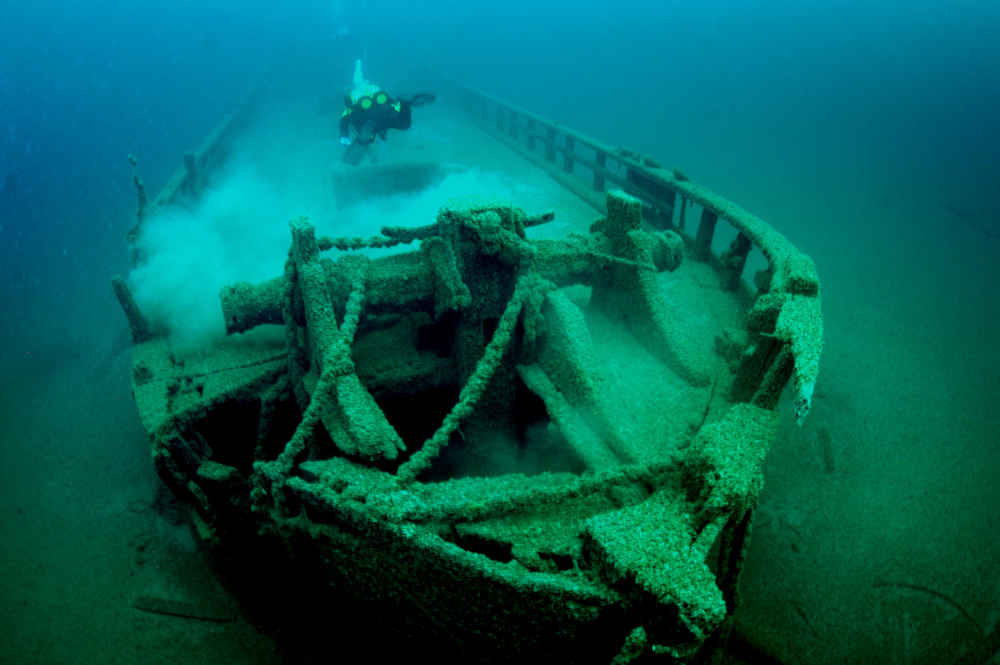
By Kris Leonhardt
Editor-in-chief
KEWAUNEE COUNTY – Wisconsin Shipwreck Coast National Marine Sanctuary is working toward community engagement for its region on Wisconsin’s shore of Lake Michigan.
The National Oceanic and Atmospheric Administration (NOAA) designated the area as a national marine sanctuary in 2021.
It is the nation’s 15th designation of its kind, joining the Florida Keys, Monterey Bay, the Olympic Coast and others.
The 962-square-mile sanctuary protects and celebrates 36 historically-significant shipwrecks – 21 that are listed on the National Register of Historic Places – and is co-managed by the state of Wisconsin.
“Well-preserved by Lake Michigan’s cold, fresh water, several of the known shipwrecks are essentially intact and look much like they did when they sank. The area also includes Wisconsin’s two oldest known shipwrecks, and archival research suggests there may be dozens more yet to be discovered,” a NOAA release stated.
“Spanning the early 1800s through the 20th century, the shipwrecks represent a cross-section of vessel types that played critical roles in transforming the Great Lakes from a maritime frontier into the nation’s busiest waterway. The ships carried grain and raw materials east as other vessels traveled west loaded with coal, manufactured goods, and settlers.”
“This sanctuary began with a community-based nomination, so the idea of engaging the communities is really baked into sanctuary management,” added Wisconsin Shipwreck Coast National Marine Sanctuary Superintendent Russ Green, who works on the University of Green Bay Sheboygan campus.
“For example, we’re currently working on a facility strategy — where would our offices go, visitor experiences, venues, research and operations, etc… — and have had several working groups with about 60 stakeholders from city leadership to nonprofit to state and university partners.”
The sanctuary’s tagline: Wisconsin Shipwreck Coast NMS provides stewardship for our national maritime heritage in Lake Michigan and promotes Great Lakes conservation through research, education and public engagement.
Creating a ripple effect
“They are incredible historic sites, and they give us an opportunity to share those stories with the public, but also manage them creatively to find ways that we can use those sites to make impacts assure tourism, recreation, impacts and education, so we get creative with the way we manage this place,” Green explained.
At the sanctuary, teachers and scientists work together to further understand the Great Lakes and increase stewardship of Lake Michigan.
Part of the initiative involves bringing teachers on-site for a full-emersion program.
“We hope they take some of this into the classroom and begin to use it to enhance their teaching. But what we really want to do is circle back with them after they’ve had a chance to think about this experience,” Green explained.
“And let us know how could we do this sustainably can we create a ‘teacher at sea’ program? So every year we’re having more and more educators on board and make that a tailored and a sustainable experience that’s meaningful, that really gets at the kinds of things they need. So we’re looking forward to these teachers telling us what we can do to set that path to create a really great education program at the sanctuary.”
However, the sanctuary serves a variety of other education roles as well.
“In between that is the entire story of westward expansion and immigration and settlement innovation technology all captured in the shipwrecks that are in the sanctuary,” Green added.
New recreational opportunities and tourism options are also arising out of the mission.
“Some of them you can see through paddleboard, particularly up in Two Rivers. Diving is a great way to do it; there’s actually a new dive shop in the sanctuary. There are now two,” he said.
And then there’s this whole third dimension that’s really evolved over the last couple of years, which is virtual experiences. And folks that may not come to the lake shore. Can we deliver messages about conservation and our national maritime heritage to those folks.”
Advisory council
The sanctuary is also working on community interaction through the development of an advisory council.
“The advisory council brings members of the local community together to provide advice to NOAA and help guide sanctuary management. Council members also act as liaisons to their communities, building a strong connection between the sanctuary and stakeholders,” Green explained.
The council held its first meeting on March 16, but is currently seeking applicants for six vacant alternate seats.
The seats include: diving/dive clubs/archaeology, K-12 education, higher education, fishing, history/heritage/public interpretation and recreation.
For more information https://sanctuaries.noaa.gov/wisconsin/involved/ or contact [email protected].
